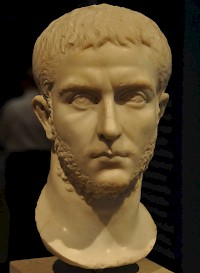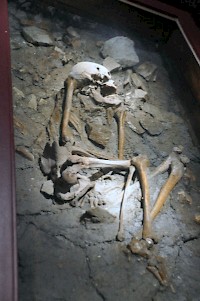Germania Inferior (10)
Q152136Germania inferior: small province of the Roman empire, situated along the Lower Rhine. Its capital was Cologne.
The Third Century

The second century seems to have been a quiet period in the history of the Roman empire, although it has to be stressed that this impression is partly due to the fact that we have only a few sources for this century.
The reign of Marcus Aurelius (161-180) marks the end of tranquility. On several fronts, the enemies of Rome became more aggressive, and the Rhine frontier was no exception. In 173, the Chauci circumvented the Dutch limes by sea and attacked the western part of Gallia Belgica. The destruction of several towns along the Scheldt can been dated to 170s; several farms near Tournai were laid waste; and it was necessary to rebuild Thérouanne and Arras, the capitals of the Nervians and Atrebates.
The governor of Belgica, the energetic Didius Julianus, recruited new troops in Tongeren and expelled the invaders. One of the forts he built during this war has been discovered near Maldegem, and the construction of a new line of defense along the coast (e.g., Aardenburg) can be dated to these years. The Romans spared no expenses: tens of thousands of tons of natural stone were transported from quarries near Tournai and in the Eifel mountains to the coastal plains. The forts along the Rhine were reconstructed as well. For example, fort Utrecht were rebuilt by the emperor Septimius Severus (193-211).

These building projects were sufficient to keep Germania Inferior safe. However, things had started to change. Every year, people migrated from the east bank to the Roman empire. Usually, they served as laborers on the farms. There was nothing new about it and it was to be expected that they would adopt the Roman way of life. But from now on, their numbers started to increase. The inhabitants of Germania Inferior were also used to minor raids by Germanic warriors. Usually, the army was able to defend the province. But the frequency of these raids was rising, and retaliation was sometimes late.
This encited other war lords, and in this way, the frontier zone was destabilized. In the 240s, the line of defense along the Lower Rhine collapsed and burning layers indicate that many forts were sacked. However, the Roman army was able to restore order. Road repairs and milestones between The Hague and Voorburg show that the country was tranquil again during the reign of Decius (249-251).
Another change was irreversible. During transgression phases, the sea is more aggressive than under normal circumstances. The third century saw the beginning of an era of increased violence from the sea. The canal between Lake Flevo and the Wadden Sea widened and the mud-flats of the north become wetlands. The Frisians and Chauci increased the height of the terps (the mounds on the alluvial plain on which they lived) but in vain. It seems that their country was largely depopulated, and the Frisians disappear from our sources. (It is unlikely that the inhabitants of modern Friesland are related to the ancient Frisians.)
Now the dangers of the salt extraction became visible. When the tide was out, the Morini, Menapians, and Frisiavones had explored the salty peat under the mud-flats by digging large holes. The result was that the flood could penetrate in full strength to the coast. And beyond, because the peat moors had been developed as well, which meant that the pillows of peat had been drained and the surface level lowered.
The coast of Flanders and Zeeland receded for almost thirty kilometers and the region started to look like an archipelago. It is no coincidence that no dedication to the goddess Nehalennia can be dated after 227, because the sanctuary at Ganuenta was destroyed by the sea. The climatic change itself was inescapable, but had become catastrophic by human interference. (The same was to happen in the twelfth century.)

At the same time, the size of the population in the Rhineland started to diminish. The hinterland of Cologne has been studied in detail, and it is known that many villages were deserted. This process started quietly, but it gathered momentum and after 275, the countryside was completely depopulated. The only town that continued to prosper (and grow) was Cologne: some 20,000 people lived within its walls. The Dutch river area was depopulated as well: at Berg en Dal (near Nijmegen), the production of roof tiles came to an end, the temple at Empel had fallen into ruins before 275, and the number of Batavian villages diminished. An analysis of ancient pollen proves that there were more forests, which suggests that many peasants had left their farms. The economy, which had always been out of balance (above), suffered severely.
The cause of this devastation is easy to find: raids of a new Germanic tribe, the Franks. They were better organized than the older tribes, more aggressive, and at the same time more like the Romans: their farms were better, they could read and write (usually called runen), and knew how to organize a long expedition into enemy territory. Germania Inferior would never be the same again.
We already noticed above that the Roman line of defense in the Dutch river area temporarily collapsed in the 240s. This was repeated in 256-258, when the Franks, who knew that troops had been transferred from the Rhine to fight against Sasanian Persia, infiltrated Germania Inferior again, and marched into Gaul. Archaeology shows what happened. The forts along the Lower Rhine were evacuated and destroyed. The inhabitants of Krefeld had no opportunity to mourn their dead and were forced to throw them in an underground sanctuary of Mithras. Trier was sacked. The only surviving city was Cologne, which was saved by its giant walls.

The emperor Gallienus hurried to Gaul, liberated Trier, reorganized the defense of Germania Superior and Gallia Belgica, and managed to expel the Franks. However, his success was not the result of a military victory: he had paid lots of gold to another Germanic tribe, which attacked the Frankish homeland. This was not the way the Romans wanted to deal with enemies, but in 259, large parts of the frontier had been restored.
Gallienus left the recapture of the forts along the Lower Rhine to the governor of Germania Inferior, Postumus. However, he had interrupt his campaign in 260, on hearing bad news from the east: during the Persian war, Gallienus' father and co-emperor Valerian had been taken captive by his enemy Shapur. This was the incentive the Germanic tribes needed, and Frankish and Alamannic warlords recrossed the Rhine. Within a few months, they had reached northern Italy.
While Gallienus was defending the Mediterranean world, Postumus restored order in the Dutch river area. Somewhere near the shrine of Hercules Magusanus at Empel, he defeated the Frankish invaders. His victory must have been decisive, because we don't hear about Germanic raids for more than a decade.

Postumus was proclaimed emperor by his soldiers, and became the founder of the independent and strong Gallic Empire, which lasted for fourteen years and occupied all of Gaul and Britain. It seems that Postumus allowed Franks to settle in Germania Inferior, which led to the reoccupation of farmland. However, this policy, which had been initiated long time ago by Marcus Aurelius, had only temporary results.
Postumus' most important contribution to the stability of the Gallic empire was a new military strategy - defense in depth. The usurper understood that one line of forts along the Rhine was insufficient: if the Franks broke through, it was impossible to stop them. Along the river, he stationed frontier troops; he constructed a line of guardposts along the line Aardenburg - Velzeke - Mechelen - Tongeren - Maastricht - Cologne; and behind this line, he positioned cavalry units, which could swiftly move to any sector under attack. In this way, the Franks could never threaten the important road between Boulogne, Bavay, Tongeren, and Cologne and the important loess area.
Postumus' empire survived its founder, who was assassinated in 269. However, in 274, the central government of Rome decided that it had to reconquer the northwestern provinces. The emperor Aurelian crossed the Alps and defeated his colleague Tetricus near Châlons sur Marne, in one of the most bloody battles that was ever fought in a Roman civil war.

The victor proudly called himself restitutor orbis, 'rebuilder of the world', and from an Italian point of view, he was right. However, his successes were the greatest catastrophe in the history of Gaul and the Rhineland. Many soldiers were dead, and the Frankish and Alamannic warlords easily overran all country north of the Alps. Many Rhine forts were sacked (e.g. Remagen), and lack of manpower caused the fall of the remaining military settlements. Cologne and Trier were captured and looted, Neuss was destroyed, Maastricht depopulated, Voorburg abandoned, and Bavay razed to the ground. Many people in Tongeren never received a proper burial.
Saxonian pirates also intervened and may have been responsible for large-scale destruction in Flanders. The Roman fort at Aardenburg was never occupied again. In several towns in northern France, hastily constructed walls were destroyed by the invaders: Metz and Reims were sacked and Paris was burning. Extensive areas in Germania Inferior were now depopulated, like the hinterland of Cologne.
Those parts of Gaul that were left in peace, fell victim to another plague: the inhabitants were forced to pay high taxes, which were used to maintain the armies of the Danube and Euphrates. The Rhine frontier was left unguarded, and countless Alamanni and Franks settled in the Roman empire. Aurelian ought to have called himself destructor orbis.